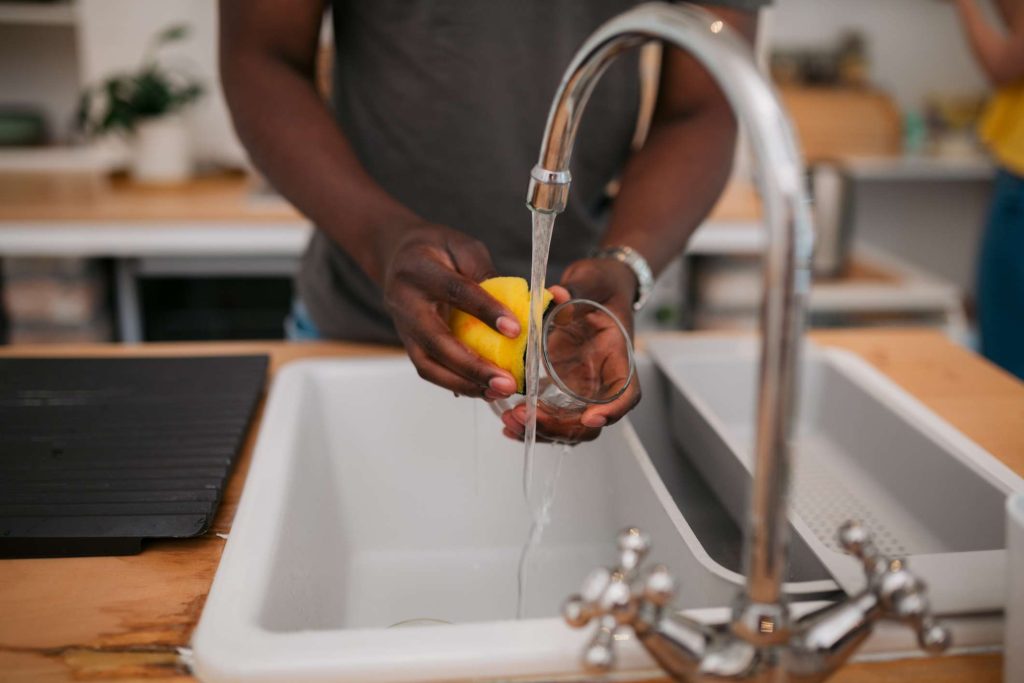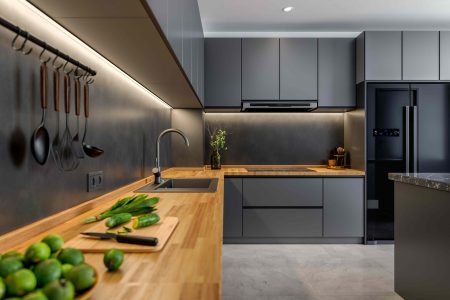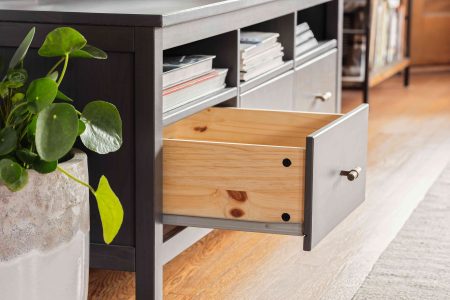The kitchen sink is a focal point of the kitchen used in food preparation, cleaning, and regular home maintenance. It is a necessity in many homes, serving as a place to wash dishes, rinse fresh vegetables, drain pasta, and more. You can use the deep basins as the perfect location to defrost meat without worrying about making a mess or simply use the kitchen sink to soak dishes with stuck-on food, making it easier to scrub the dishes clean a short time later.
With the broad variety of applications and uses, it’s important to be selective about your kitchen sink material. Some material options are more durable, allowing them to stand up to heavy-duty use in a busy household, while other kitchen sink materials are valued for the elegant finish that helps improve the aesthetic of the home. Consult the helpful guide below to learn more about the various types of material for the kitchen sink with the detailed assessment of the benefits and drawbacks of each material.
-
01
of 13Stainless Steel
Best for: Affordability, durability, and low maintenance.
The most common option for a kitchen sink material is stainless steel. This material is well-known for its water-resistance, durability, and scratch-resistance, and is also often recognized for superior rust-resistance and antimicrobial properties. Stainless steel is an excellent choice for just about any kitchen. It’s relatively easy to clean, heat-resistant, and the stainless steel finish looks great alongside stainless steel or chrome appliances.
A drawback to stainless steel as a kitchen sink material is that it can be noisy when you drop dishes, pots, pans, or utensils into the sink. Beyond this minor problem, the only thing you need to worry about with stainless steel is water spots. As long as you keep the sink relatively clean, stainless steel is a top option for your kitchen.
-
02
of 13Copper
Best for: Antimicrobial properties and an attractive finish.
When most people think of kitchen sinks, they don’t often imagine copper as the material. However, this kitchen sink material is an excellent option for keeping the home clean.
Copper also provides an attractive focal point that helps the sink stand out in the kitchen. It’s important to consider the high price associated with copper kitchen sinks, as well as the low durability of the material. While copper looks great, it’s vulnerable to scratches, dents, and dings from heavy or sharp objects, so it may not be the right choice for a family home with small kids.
-
03
of 13Enameled Cast Iron
Best for: Stain-resistance, durability, and traditional style.
The high durability of enameled cast iron makes it an excellent option for a kitchen sink. Cast iron is a heavy material that won’t flex or dent, though it’s important to ensure that the cabinets are able to hold the weight of the sink without buckling or warping. The enameled coating on the cast iron is non-porous and stain-resistant, ensuring that the cast iron is protected from water, rust, and corrosion.
You can find a wide range of enameled cast iron kitchen sinks in a variety of styles. However, it should be mentioned that the enameled layer protecting the cast iron base is vulnerable to chipping or scratching from sharp or heavy objects. If this happens, the cast iron layer will be exposed to water, resulting in rust and corrosion. Take care to place items into the sink, instead of dropping them, and only clean the sink with a mild cleaner or detergent.
-
04
of 13Fireclay
Best for: High durability, easy maintenance, and long lifespan.
The best part of a fireclay kitchen sink is that it has a long lifespan that will last for years of regular use without needing to be replaced. Fireclay is a highly durable material that holds up better than even enameled cast iron. This type of kitchen sink is resistant to stains, scratches, and dents, though it may need to be reglazed at some point, depending on the severity and frequency of use.
Fireclay sinks have a relatively limited color selection and they require a reinforced countertop and cabinetry to support the weight of the fireclay. This material also tends to be more expensive than other common kitchen sink materials, and typically needs to be professionally installed, so it may not be the right choice if you are looking for an affordable option.
Continue to 5 of 13 below. -
05
of 13Enameled Steel
Best for: Affordability and stain-resistance.
With a similar look as enameled cast iron, enameled steel is the way to go if you are trying to keep more money in your wallet. The inexpensive material boasts the same stain-resistant qualities as enameled cast iron, without the heavy construction and higher price tag. Due to the nonporous enamel layer coating the steel, this material is easy to keep clean and requires minimal maintenance.
However, you need to avoid dropping any heavy or sharp items into the kitchen sink if you choose to go with enameled steel because this material is susceptible to dents, chips, and scratches. Once the enamel layer is damaged, the steel becomes vulnerable to rusting and corrosion. Make sure to clean with gentle soap and water, instead of abrasive chemical cleaners.
-
06
of 13Solid Surface Acrylic Resin
Best for: Affordability, lightweight installation, and customization.
Made with acrylic resin, this kitchen sink material is typically referred to as solid surface, though there are various brand names that market this material differently, such as Formica or Corian. Just keep in mind that solid surface kitchen sinks are sensitive to heat, prone to scratches, and tend to have a short lifespan than other kitchen sink materials.
-
07
of 13Quartz Composite
Best for: High durability, heat-resistance, and sound dampening.
If the vulnerabilities of solid surface acrylic resin or enameled kitchen sinks are concerning, then a quartz composite kitchen sink is a great option. This material is inexpensive, but high in durability, made with a mixture of natural stone and acrylic resin in an attempt to mimic the look and feel of a true natural stone sink.
Quartz composite is highly resistant to heat, chips, scratches, and staining. The material helps to dampen sounds, so you won’t need to worry about loud noises if you drop a utensil or pan into the sink. This type of sink is also relatively easy to keep clean with water and mild soap. However, you should keep in mind that the tough material isn’t forgiving to delicate dishes or glasses if they are dropped into the sink.
-
08
of 13Granite Composite
Best for: Low maintenance, heat resistance, scratch resistance, and stain-resistance.
Granite composite kitchen sinks are another option created by mixing acrylic resin with natural stone. Specifically, natural granite is mixed with acrylic resin to form this heat-resistant material that mimics the appearance of natural stone. This material is also resistant to scratches, chips, cracks, and stains, with a high level of durability that makes it a great option for busy kitchens.
The material also dampens the sound of objects dropped into the sink, though delicate glassware and dishes are prone to breaking when they are dropped on this material. For this reason, it’s better to place items into the sink, instead of tossing or dropping them. Also, before installing a granite composite kitchen sink it’s necessary to ensure the cabinet and countertops are properly reinforced, so they don’t buckle under the weight.
Continue to 9 of 13 below. -
09
of 13Brass
Best for: Attractive finish and antimicrobial properties.
Brass is an alloy of copper and zinc, so it should come as no surprise that this kitchen sink material is valued for its attractive appearance, natural patina, and antimicrobial properties. It’s also somewhat stronger than copper, though they both come at a high price point.
Additionally, brass isn’t a highly durable material. it’s vulnerable to scratches, dents, dings, and harsh chemicals, so you should only clean the sink with mild soap and water to avoid wearing away the finish. If you don’t like the look of the patina that forms on brass over time, then you will also need to seal the brass sink to keep it protected.
-
10
of 13Acrylic
Best for: Affordability, low maintenance, and versatile style.
Acrylic is a low maintenance material that is regularly used to make a range of versatile sink styles due to the easy moldability of the material. However, it is susceptible to scratches and dings from sharp objects being dropped or tossed into the sink. Additionally, extremely hot pots and pans can damage the acrylic, so you will need to be sure that any hot items are allowed time to properly cool before putting them into the sink.
Despite the drawbacks, this material is an inexpensive choice for a kitchen sink. It’s strong, sound absorbent, easy to keep clean, and resistant to mold, mildew, dirt, and grime. Minor scratches can be repaired with a car buffing compound, but it’s still recommended to use gentle cleaners, instead of abrasive brushes and harsh chemicals.
-
11
of 13Vitreous China
Best for: Minimalist design, low maintenance, and stain resistance.
If you are looking for a traditional or minimalist style, then vitreous china may be the solution. This material is made by heating glass and applying the glass enamel to traditional porcelain in order to increase the durability and strength. The nonporous layer of enamel helps improve the resistance to scratches, chips, and stains, while making the sink easier to clean.
-
12
of 13Porcelain
Best for: Easy to clean, low maintenance, and traditional design.
Porcelain is similar to vitreous china, though it has a more traditional appeal. This material has been used for centuries to make sinks, toilets, and dishware by firing potter stone and kaolin at extremly high temperatures. Porcelain is an affordable, easy to clean material with moderate stain, heat, and scratch resistance. However, it tends to be heavier than vitreous china, especially if it has steel or cast iron reinforcement.
Continue to 13 of 13 below. -
13
of 13Stone
Best for: Heat resistance, long lifespan, and highly durability.
One of the most costly options for a kitchen sink is natural stone, like marble or granite. Stone is a high-durability material that is resistant to scratches, dents, chips, and heat. It has an attractive modern appeal, however, it’s necessary to seal the stone sink to prevent the porous material from absorbing liquids and becoming stained or discolored. Additionally, the countertop and cabinets may need to be reinforced to hold the weight of the stone kitchen sink.
Choosing a Kitchen Sink Material
The right kitchen sink for your home depends on a variety of factors, including personal preference, aesthetic design, durability, maintenance, cost, lifespan, and resistances. There are many materials that work well in low-traffic kitchens, such as copper, brass, and solid surface acrylic resin. These options tend to be more vulnerable to physical damage, like scratches and dents, while materials like quartz composite or stainless steel boast a high level of durability that makes them ideal for high traffic kitchens.
If cost is a primary factor, then opting for more inexpensive materials is a great way to save on a new kitchen sink. Consider affordable materials, like solid surface acrylic resin, enameled steel, full acrylic, and stainless steel for your kitchen sink. Cleanliness and sanitation are also important to keep in mind. Copper, brass, and stainless steel all boast antimicrobial properties, helping to keep the kitchen clean and free of bacteria. Weigh these factors and select the right material for your home.
Read the full article here









